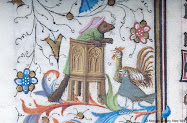 Spring has come late to these parts, and today was one of the first days there was real heat in the sun. I sat on the front porch reading, enveloped in the scents from the jasmine and climbing roses that are running riot around the balcony, watching the fat, furry bumbler bees (as my nephew calls them) slip dozily from bloom to bloom. My coursework is done for the year, so I now have the summer ahead of me to mull over the research project that will occupy a lot of my time over the coming year.
Spring has come late to these parts, and today was one of the first days there was real heat in the sun. I sat on the front porch reading, enveloped in the scents from the jasmine and climbing roses that are running riot around the balcony, watching the fat, furry bumbler bees (as my nephew calls them) slip dozily from bloom to bloom. My coursework is done for the year, so I now have the summer ahead of me to mull over the research project that will occupy a lot of my time over the coming year.I’ve got some broad ideas about what I want to tackle and how, but I haven’t refined the research question(s) so narrowly yet as to require really intensive reading (or to get alternately obsessed and fed up with the subject). I’m interested in taking up Joan Scott’s challenge to examine the ways that ‘gender constructs politics and politics constructs gender’, so I’m thinking I may do something around competing constructions of misrule and the gendering of dissent during the troubled reign of Richard II of England. That leads to lots of related threads - starting with that classic late medieval triangle of heresy, sodomy and treason - that could also prove rich avenues for investigation.
I love this stage of the process, where I can dip in and out of lots of different books and articles, following up any little obscure angle that intrigues me. It suits my magpie brain. I have a nice big stack of background reading, theory, and secondary sources on the period to work through over the next couple of months, and I’ll also be making a start on tracking down primary sources I may want to use. There is a huge amount of this material for Richard’s reign and its post-deposition aftermath, including a bunch of French and English chronicles and extensive judicial and administrative records. (Bonus - thanks to the prompt from Dame Eleanor Hull, I also discovered my university library has an edition of the Calendar of Patent Rolls for Richard II’s reign stashed in offsite storage, so I won’t need to interloan.)
As this project takes shape over the coming months, I will probably torture you periodically with oblique accounts of my discoveries. But for now, I’m going to go and pour myself a glass of cider, so I’ll leave you with my thoughts on other good things about summer:
- Monteiths Crushed Apple Cider served over ice in a big goblet
- Hitting the single track at Makara Peak
- Eating fish and chips on the beach, and washing away the salty, greasy goodness with a glass of crispy sauvignon blanc
- Swimming twilight laps around Oriental Bay fountain
- Breaking out the fairy lights and turning our patio into a Greek-taverna-by-proxy
* The image is of a 14th century music manuscript of the English round Sumer is i-cumen in.












